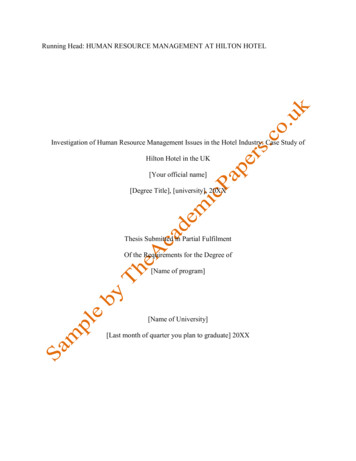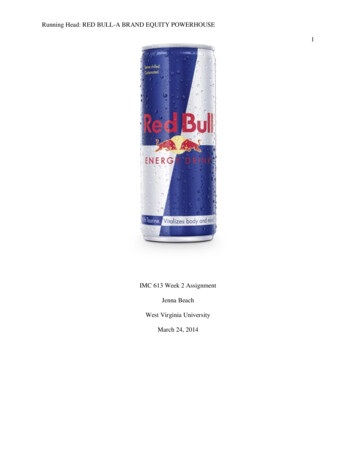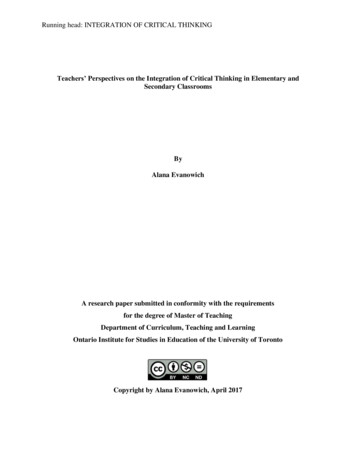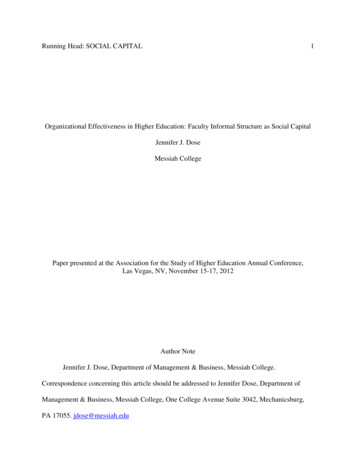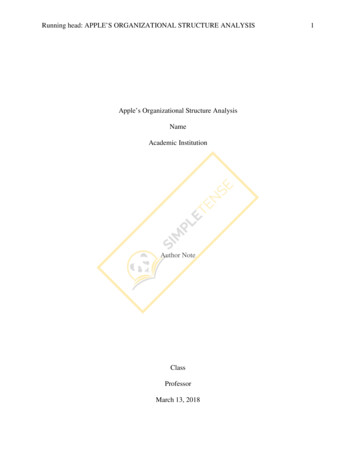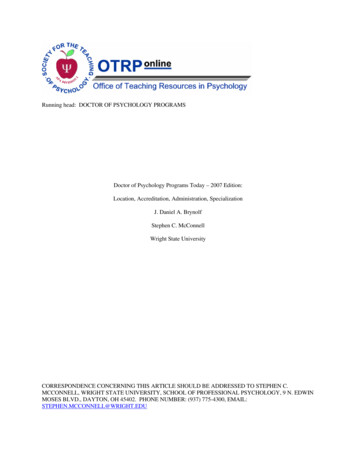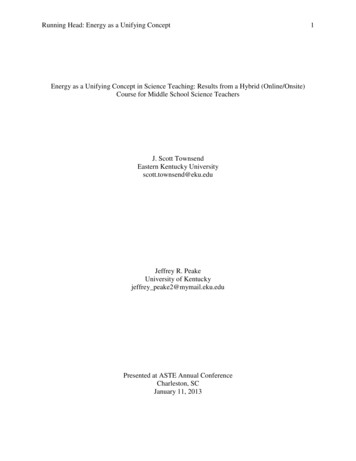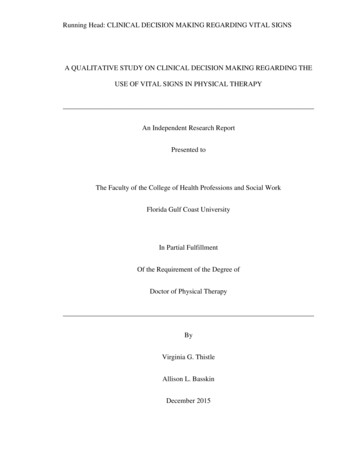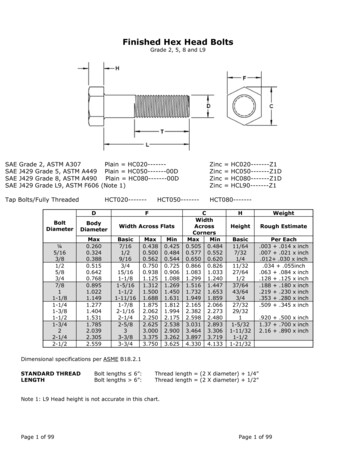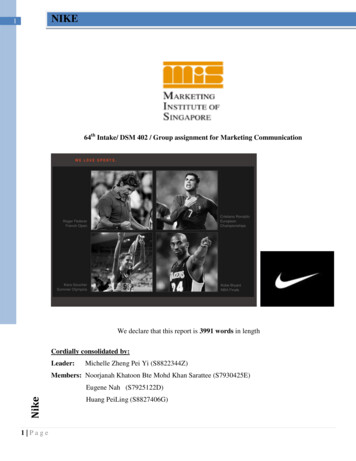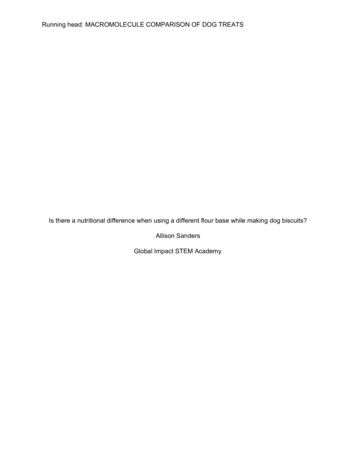
Transcription
Running head: MACROMOLECULE COMPARISON OF DOG TREATSIs there a nutritional difference when using a different flour base while making dog biscuits?Allison SandersGlobal Impact STEM Academy
MACROMOLECULE COMPARISON OF DOG TREATSTable of Contents1. Abstract .pg. 32. Literature Review .pg. 4-53. Plan A (Problem, Hypothesis, Variables).pg. 64. Plan B (Materials, Procedure, Data, Conclusion).pg. 7-145. References .pg. 152
MACROMOLECULE COMPARISON OF DOG TREATS3AbstractThe purpose of this project was to compare the amount of macromolecules that would beabsorbed from four different flour based dog biscuits (soy, sorghum, wheat, and brown rice),and determine which base would benefit dogs the most. It was believed that the soy flour baseddog biscuits will have a higher digestibility rate and more nutritional absorbency due to the factof soy flour having the highest amount of protein, as stated by the labels of the flour. The fourbiscuit types were tested for different macromolecules (starch, complex and simple sugars,protein, and calories) using the Iodine, Benedict’s, Bradford, and Calorimeter tests afterdigestion. The Iodine test was used to determine the presence of starch; the Benedict’s test wasused to determine the presence of simple sugars; the Bradford test was used to determine theabsorbance of protein, which could then be interpolated on the standard curve graph todetermine concentration levels, and the Calorimeter test was used to calculate how manycalories are contained in one gram. The data concluded that compared to the other flour bases,the soy flour based biscuits had the best overall nutritional absorbency readings with the highestBenedict’s test and the lowest amount of calories calculated by the Calorimeter test. Theexperiment did support the hypothesis. These results were expected due to the fact of soybeansbeing a complete protein as well as a main source for other vitamins and minerals, thustransferring into having the most nutritious flour source based off the label. The importance ofthe project was to learn which flour source would be the most beneficial to dogs as well as beingthe most cost effective alternative for pet owners.Keywords: nutrition, soy, dogs, macromolecules
MACROMOLECULE COMPARISON OF DOG TREATS4Literature ReviewIs there a nutritional difference when using a different flour base while making dog biscuits?Summary OneIn “Glycemic and Insulinemic Responses after Ingestion of Commercial Foods in HealthyDogs: Influence of Food Composition”, a study was conducted to see if there is a correlationbetween diets causing hyperinsulinemia and obesity. Twelve adult beagles were tested andserum glucose and insulin concentration were calculated after meals. Results concluded thatthe amount of starch in a diet determines the glucose response, but may vary due to activitylevels.Evaluation OneThis article seems to be credible. It has many websites and a footnote cited, and ispublished by a nutrition company. This is also a ‘.org’ network, which tends to be more reliablethan ‘.com’. This article seemed in no way opinionated, due to the fact that it presented manyfacts, and the actual data tables from the study.Summary TwoIn “Grain-Free Pet Food Trend a Hoax?”, Dr. Donna Solomon, a veterinarian fromChicago, examines the nutritional difference between grain free diets and non grain free diets todetermine if there is a benefit. It was mentioned that dogs with many food allergies tend to dobetter with grains in their diets, especially rice. It was determined that the grain free diets arejust a myth.
MACROMOLECULE COMPARISON OF DOG TREATS5Evaluation TwoAlthough the article was written by a professional veterinarian, it was also published onThe Huffington Post’s website, therefore some bias was detected. However, the information waswell presented, and also provides examples of the other side of the argument. In conclusion,some of the information from this source is credible, but some could have been seen as biased.Summary ThreeIn “Soy Protein Increases Glomerular Filtration Rate in Dogs with Normal or ReducedRenal Function”, a study was conducted with dogs that have normal kidney function and dogsthat have compromised kidney function to determine if one protein source would help over othersources. The dogs with normal kidney function were given four protein sources, (casein, soymeal, soy flakes, and purified soy protein), while the dogs with reduced kidney function weregiven three protein sources (casein, purified soy protein, and pork liver). The experimentconcluded that soy proteins have the same benefits on kidney function as animal proteins.Evaluation ThreeThis article seems to be credible. It is from an ‘.org’ network rather than a ‘.com’ network,which is typically considered to be a more credible source. The article also has citations andfootnotes from other published works. This article seems in no way opinionated, due to the factthat it explained every step of the research and experimentation that the authors conducted.Plan A:Problem: When looking for a sustainable dog biscuit alternative, is there a nutritional differencebetween four different flour bases, soy, sorghum, wheat, or brown rice.Hypothesis: It is believed that the soy flour based dog biscuits will have a higher digestibility rateand more nutritional absorbency due to the fact of soy flour having the highest amount ofprotein, as stated by the labels of the flour.
MACROMOLECULE COMPARISON OF DOG TREATS6Variables:Independent: Flour typeDependent: Amount of macromolecules adsorbedControls: Same amount of gastric juice, same cooking time, same baking methods, sametesting methods, same size equipment, same amount of ingredients, same digestion time, samecookie cut out, etc.
MACROMOLECULE COMPARISON OF DOG TREATSPlan BMaterials: Peanut butter Bob’s Red Mill Soy flour Bob’s Red Mill Sweet Sorghum flour Bob’s Red Mill Brown Rice flour Enriched white flour Quick oats Water Measuring cups Bowls Cookie cutter Cookie sheet Honey Eggs Baking soda Bradford solution Benedict’s solution Iodine solution Cuvettes Pipettes Strainer Permanent marker Test tubes Test tube racks Filter paper Strainer Magnetic stirring hot plate Magnetic stir bar Beakers Gastric juice Electronic balance Mortar and pestle Micro well plate Spectrophotometer Soda can Cork Bamboo skewer Paperclip Lighter Electronic balance Graduated cylinder7
MACROMOLECULE COMPARISON OF DOG TREATS 8Ring stand with clampSafety gogglesThermometerProcedure:Baking the Dog Treat Samples:1. A convection oven was preheated to 176 degrees Celsius (350F).2. In a large mixing bowl, 2 ½ cups of wheat flour was added to 1 tsp of baking soda and 1egg, and stirred.3. 1 cup of peanut butter was added to the bowl along with 1 cup of water and 2tablespoons of honey.4. The mixture was stirred and kneaded until a dough - like mixture formed.5. 1 cup of oats was added to the dough.6. On a lightly floured surface, a quarter of the dough was rolled out to form ½ inch treats.7. A floured cookie cutter was then placed into the dough to cut out 10 dog treats.8. The cut out treats were then put on a baking sheet, and put in the oven for 20 minutes.9. The cooked treats were then placed on a sheet of wax paper to cool for testing.10. Steps 1-9 were repeated for each of the following flour sources (soy, sorghum, andbrown rice).Digestion of Dog Treat Samples in Gastric Juice:1. 20g of each dog treat sample was measured out, and added to a beaker with 85mL ofgastric juice.2. Samples were placed on a hot plate at 39 degrees Celsius, and a magnetic stir bar wasadded.3. The stir setting was then set to 300 rpm, and samples were left to sit for 7 hours.4. After 7 hours, samples were then filtered with a fine mesh strainer.5. The filtrate was then used to complete the Carbohydrate and Protein Indicator tests.Monosaccharide Indicator Standard Test (Glucose):1. In a test tube, 1mL of the wheat dog food treat filtrate solution was added to 1mL ofBenedict’s solution.2. Samples were then given a quick mix.3. Steps 1-2 were repeated 9 more times with the same filtrate.4. All 10 test tubes were then placed in a boiling water bath for 2 minutes.5. Steps 1-4 were repeated with the other flour bases (soy, sorghum, and brown rice)filtrate solution.6. After 2 minutes, the test tubes were analyzed based on color change (0 no colorchange/negative – 3 very strong/ positive), and data was recorded.7. After trials were then compared to known standards.Complex Carbohydrate Indicator Standard Test (Starch):
MACROMOLECULE COMPARISON OF DOG TREATS91. In a test tube, 1mL of the wheat dog treat filtrate was added to 7 drops of Lugol’s IodineSolution.2. Samples were then given a quick mix.3. Steps 1-2 were repeated 9 more times with the same filtrate.4. Trials were then analyzed by color change (0 no color change/ negative – 3 verystrong/ positive), and data was recorded.5. Trials were then compared to known standards.6. Steps 1-5 were repeated with the other flour based (soy, sorghum, and brown rice)filtrate solution.Protein Indicator Standard Test:1. 10 cuvettes were labeled for each filtrate solution.2. 30μL of each filtrate solution was placed in the appropriate cuvettes, and 1mL ofBradford 1X Dye was added.3. Cuvettes were then inverted 3 times.4. Trials then sat for 5 minutes.5. After sitting, the trials were placed one at a time, starting with the known standards, intothe Vernier SpectroVis Plus, and absorbance readings were recorded.6. A standard curve graph was created with the given protein concentration versus itsabsorbance reading.7. For each filtrate sample, the average absorbance reading was then interpolated on thestandard curve graph.Calorimeter Test:1. A paper clip was pushed through the middle of a cork.2. The cork was then placed into the bottom of an empty metal coffee can.3. A small piece of the wheat dog treat sample was weighed using an electronic balance,and mass was recorded.4. 50mL of water was added to a cleaned empty soda can, and the temperature wasrecorded.5. A bamboo skewer was then used to suspend the soda can on top of the coffee can 2.5cm above the cork.6. The wheat dog treat sample was then stuck through the paper clip, and a lighter wasused to set the sample on fire.7. After the fire went out the remains of the treat sample was then reweighed, and thewater in the can was remeasured and recorded.8. Steps 1-6 were repeated for each flour base sample (soy, sorghum, and brown rice).9. Using the equation Q 50 Δ T where T equals temperature change (after burningtemperature - initial temperature), the variable Q was solved for.10. Using the equation Q/1000 Calories (kilo-calories), the number associated with Q wassolved for how many kilo-calories were in the sample.11. The amount of kilo-calories was then multiplied by the Δ W where W equals the weightchange (initial - after burning weight).
MACROMOLECULE COMPARISON OF DOG TREATS1012. The answer to the final equation is the amount of calories in the dog treat sample.13. Steps 1-11 were repeated for each flour bases (soy, sorghum, brown rice).Data:Bradford’s Test (Protein):Protein Concentration 3010.250.1050.1250.059
MACROMOLECULE COMPARISON OF DOG TREATSProtein Averages (mL/mg)AbsorbanceWheat0.602Brown Rice0.528Sorghum0.409Soy0.528Benedict’s Test (Simple Sugar):Benedict's AveragesPercentage (%)Sorghum3.9Wheat3.2Soy4.5Brown Rice4.211
MACROMOLECULE COMPARISON OF DOG TREATSIodine Test (Starch):Iodine AveragesPercentage (%)Soy10Brown Rice10Wheat10Sorghum1012
MACROMOLECULE COMPARISON OF DOG TREATS13Calorimeter Test (calories):Sample TypeAverages (Cal/g)Brown at0.06465698Conclusion:The data concluded that compared to the other flour bases, the soy flour based dogbiscuit had the best overall nutritional absorbency readings with the highest Benedict’s test andthe lowest amount of calories calculated by the Calorimeter test. The experiment did support thehypothesis. These results were expected due to the fact of soybeans being a complete proteinas well as a main source for other vitamins and minerals, thus transferring into having the mostnutritious flour source based off the label. One factor that was surprising was that whenanalyzing the filtration liquid from each sample, the soy based biscuits produced the mostamount of filtration, meaning that the dog would absorb the most out of those biscuits comparedto the others.The importance of the project was to learn which flour source would be the mostbeneficial to dogs, which source would be the most cost effective alternative for pet owners,how to calculate the amount of nutrients absorbed from each serving (1 biscuits) to build aproduct and small business, and how changing the flour source affects the properties of a dogbiscuit.
MACROMOLECULE COMPARISON OF DOG TREATS14Possible ErrorsImprovementsCuvettes getting smudged, causinginaccurate readingsMake sure to hold cuvettes correctly, andwipe down the sidesFiltrates had to sit overnight, causing them toharden, thus water had to be added to form aliquid in order to perform testsTry to get all testing done in one dayHeat escaping into the atmosphere during thecalorimeter testTry to develop a secure area for testingFire burning out during the calorimeter test,causing a need for relighting, causingpossibly inaccurate readingsTry to use a flame hot enough to whererelighting is unneeded
MACROMOLECULE COMPARISON OF DOG TREATS15ReferencesDiekman, C. (2016). Soy Fact Sheets. Retrieved November 07, 2016, sheets/soy-flour-fact-sheetFinco, D. R., & Cooper, T. L. (2000). Soy Protein Increases Glomerular Filtration Rate in Dogswith Normal or Reduced Renal Function. Retrieved November 07, 2016, fromhttp://jn.nutrition.org/content/130/4/745
MACROMOLECULE COMPARISON OF DOG TREATS 3 Abstract The purpose of this project was to compare the amount of macromolecules that would be absorbed from four different flour based dog biscuits (soy, sorghum, wheat, and brown rice), and determine which base would benefit dogs the most. It was believed that the soy flour based
